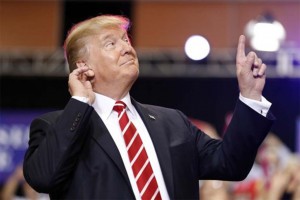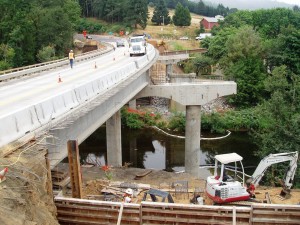
President Donald Trump is backing a 25-cent increase in the national gas tax to pay for infrastructure improvements.
Lawmakers in Hawaii have taken the first step towards adding new fees for owners of electrified vehicles, a move a Senate committee chairman describes as a way to get hybrid and EV owners to “pay their fair share” towards maintaining the state’s bridges and roads.
With the U.S. transportation infrastructure crumbling and state and federal highway funds running short, lawmakers and regulators are searching for ways to raise new money. President Donald Trump, who made a massive infrastructure program a cornerstone of his campaign for the White House, has gone so far as to suggest federal gas taxes might need to be more than doubled.
That proposal has gotten a cold reception from Congress, no surprise after Republicans barely pushed through a tax cut late last year and now face a tough midterm battle to retain control of both the House and Senate. But with taxpayers also demanding road repairs there’s growing interest in finding alternative solutions, such as pay-as-you-go fees. And even though Congress decided to retain tax credits for zero-emissions vehicles, that could be offset with new registration and usage fees.
“We need to have (owners of electrified vehicles) pay their share” for road maintenance, Lorraine Inouye, chairwoman of the Hawaiian Senate Transportation Committee, said this week as the body approved a bill that would charge hybrids owners $35 a year above existing weight taxes and registration fees, with the added cost jumping to $70 for pure battery-electric vehicles.
A number of states have begun considering such fees, proponents noting that vehicles that can run on electricity pay little to no conventional gas taxes. And with electrified vehicles expected to make up as much as half of new car sales in the U.S. by the end of the next decade that could turn into a budget buster.

A President Trump-proposed 25-cent a gallon hike in the federal gas tax would help improve the country's infrastructure.
(Ford CEO Hackett pushes company’s vision of transportation in the future at CES. Click Here for the story.)
But even conventional vehicles are pumping less money into federal and state highway coffers these days as the result of ongoing improvements in fuel economy. And with the U.S. Corporate Average Fuel Economy standard set to reach 54.5 mpg by 2025 there is widespread consensus that the Federal Highway Fund can’t keep up.
Add the fact that the federal 18.4 cent gasoline tax hasn’t increased since 1993, and you have a real funding conundrum. Just to keep up with the effects of inflation it would need to be bumped to 31 cents today. In a meeting with Congressional leaders earlier this month, Trump said he’d back a 25-cent increase.
And he’s not alone, even some traditional gas tax opponents have taken a more open stance. “Opponents of a fuel user fee fail to mention a simple fact: deteriorating roads and bridges exact a heavy price on the motoring public – and that cost hits low- and middle-income drivers the hardest,” said Chris Spear, the president and CEO of the American Trucking Associations,
Even so, the reception to talk of a gas tax hike has been decidedly cool. The 1993 increase created a political firestorm and the gas tax has been considered a “third-rail” issue ever since. “I don’t think there is support for it right now,” Representative Kevin McCarthy of California, the second-ranking House Republican, told the Bloomberg news service after the meeting with the president.
At the same time, few argue that investing in better roads would actually pay off in terms of time and money. Commuters in Los Angeles lost an average 104 hours in 2016, according to a study released by traffic research service Inrix last year, and nationwide, congestion alone cost $300 billion. That doesn’t include flat tires, broken rims and other vehicle damage from potholes and other highway defects.
So, there’s growing interest in finding alternatives ways to fund highway programs. One approach would see the U.S. migrate to a Vehicle-Miles-Traveled approach requiring all motorists to pay as they go, no matter what they’re driving.
(Click Here for more about a government panel looking to tighten drunk driving rules.)
Oregon was the first to experiment with a VMT system, in 2006 signing up 300 drivers who agreed to use GPS to clock their mileage. They were exempted from the state’s gas tax but paid 1.5 cents for each mile driven. The measure was considered a success – though, for now, Oregon has capped the number of drivers who can participate in the program at 5,000.
A study by the RAND Corporation said that the technology used to track mileage could add value for drivers and transportation planners alike, among other things “generat(ing) rich travel data for improved transportation planning.”
Making the switch wouldn’t be especially difficult, at least not for vehicles that will be coming to market in the near future. Federal regulators have been running pilot programs allowing vehicles to communicate with highway infrastructures to keep motorists informed about weather and traffic issues. Such vehicle-to-infrastructure, or V2I systems could readily track mileage and handle billing.
Later this year, in fact, Audi will begin installing an “Integrated Toll Module” in “select vehicles” that will automatically pay tolls anywhere in the U.S. and Canada. The same technology could readily handle per-mile taxes.
It’s far from certain Hawaiian lawmakers will ultimately enact the battery-car tax measure, but if they do, observers say they’d be surprised if other states don’t follow with similar funding scheme. As for VMT programs, there are plenty of opponents, from those who think it will lead to big increases in the cost of driving to those who fear the potential Big Brother aspect, the idea that government could learn not only how much they drive but when and where.
(To see more about how traffic fatalities fell slightly in the first half of 2017, Click Here.)
But with a hard winter only worsening the condition of America’s roadways, there seems to be growing agreement that new funding will have to be raised for state and federal highway funds. The challenge will be finding one that can prove politically acceptable.

A few thoughts:
– Learn to make roads durable. Analyze failed roads to determine root cause and corrective action.
– Build roads that can be easily repaired.
– All gas tax (and equivalent) is reserved for road repair/construction and cannot be used for other programs (like rail and other mass transportation, welfare, etc.)
– Repair roads as necessary before they can cause vehicle damage
– Initiate an exchange between the USA and Germany to learn best practices. Hopefully, Germany won’t learn any of our practices.
Michigan actually experimented with using a much more durable, albeit more expensive, road construction process for the short stretch of freeway known as I-375 that runs to the Renaissance Center in downtown Detroit. (It begins where I-75 makes a 90-degree hook and then zigzags down towards Toledo.) The good news is that 20-some years in it is virtually as good as new. Sadly, Jack, the state claims the added cost isn’t worth it. Few believe that and skeptics contend that local road construction companies effectively lobbied to get more frequent (and, ultimately more profitable) re-do work than getting a bit more up front for roads that would last a lot longer.
Paul E.
Ok, half the EV fee applied to the other vehicles. Everyone is unhappy except the road crew.
Georgia, which has no yearly ad valorem tax, only a $20 registration renewal fee, raised the EV fee so it is 10X ($200) the fee for combustion engine cars. At the same time, the purchase tax break was cancelled.
So $70 wouldn’t sound that bad, if it weren’t for the current administration’s intent to cut Federal participation in highway funding from the current 50-90% (depending on road classification) to 20% for new projects.